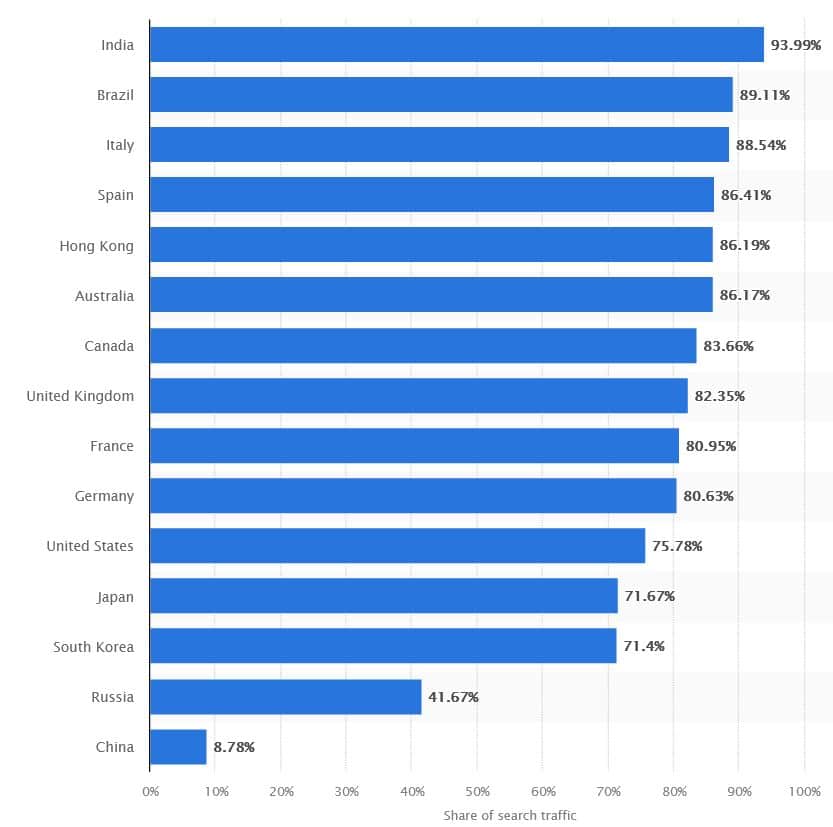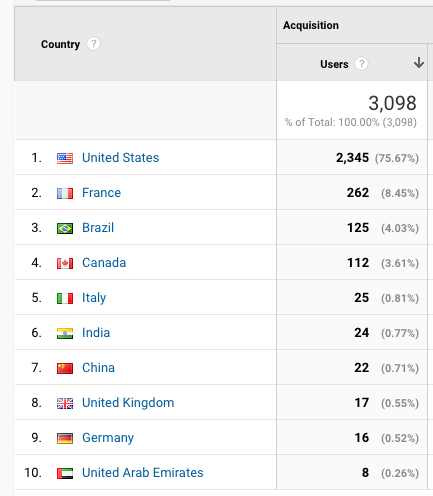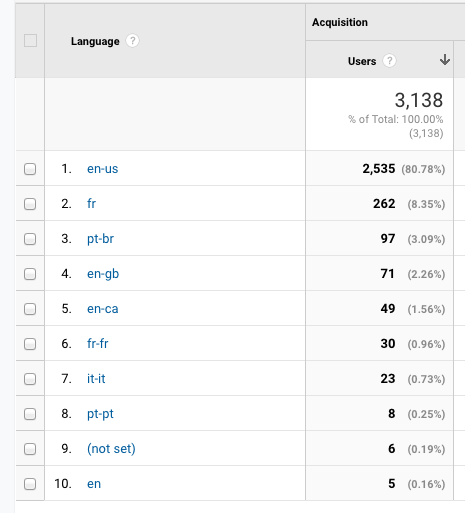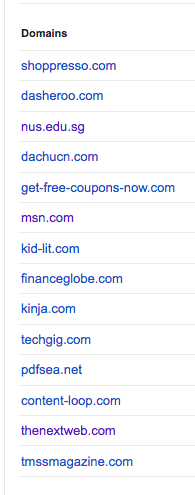For a business that sells world-wide, focusing all your time, money, and resources on only attracting organic traffic from the US can be a huge mistake. Broaden your reach with an international SEO strategy that will put you in a position to expand from both a technical and strategic perspective, thus giving your business a global boost.
According to Statista, 75.78% of US residents use Google instead of competitor search engines, as of December 2022. While there’s plenty of traffic to be had by implementing SEO strategies to target the US market, you don’t want to stop there. Here’s why:

(Source: Statista)
You’re seeing that right. Google is a major driver of organic traffic throughout the world and you’re missing out on a lot of site visitors if you don’t have a detailed global SEO strategy in place.
At this point you’re probably wondering how to do international eCommerce SEO properly.
Here are four international SEO tactics that will put you on the right track:
1. Build Your International SEO Strategy Around the Right Target Markets
With more than five billion internet users worldwide, it’s tempting to cast a wide net with hopes of generating traffic from as many markets as possible. But there’s a problem with that: you don’t know which countries are profitable and feasible to target and serve from a business perspective, as culture, language, and background can play a huge role in product interest.
Before launching an international website or implementing an international SEO strategy, it’s critical to conduct market research to evaluate the supply and demand in each market. Neglecting to do so increases the risk of spending resources to build awareness and drive traffic among visitors who don’t convert.
There are two questions that will lead you toward the right international target markets:
First, What is the existing traffic potential for each market?
Answer this question by reviewing your Google Analytics report with a focus on where your current traffic comes from. You’ll see something like this:

These numbers show an eCommerce website that’s generating most of its traffic from the US market. However, there’s a good opportunity to secure more traffic from France, Brazil, and Canada.
Second, What languages do users use in their browsers?
After choosing which countries to target in your international SEO strategies, you need to research the most common languages spoken by residents. This information will help you build content and optimize your site for the global markets you want to target.
Your Google Analytics account will show you the top 10 languages of your site visitors based on the language preference of their browsers:

English is often the most common language, but there are others, such as French in this example, that serve as a good opportunity.
2. Build Localized Content For Specific Audiences
The content that attracts and engages one audience may not resonate with another. Localization involves designing a website and its high-quality content to address the specific behavior and interests of the target audience and their culture.
Getting started means understanding the website design preferences for each culture, as this provides the best shopping and browsing experience for users.
Here are some of the many areas of a website that require local language for a customized experience:
- URLs
- Navigation
- Content
- Meta Titles
- Meta Descriptions
- Headings (h1, h2)
- Main text
- Currency
- Delivery Options
- Customer Service
- User Experience
All of these areas require your attention. Neglecting to devote enough resources to proper optimization can negatively impact both search engine rankings and conversions, effectively tanking your carefully crafted global SEO strategy.
3. Geolocation Signals to Search Engines
Search engines are smarter today than ever before, but that doesn’t mean you can optimize your website for one language and expect their algorithms to do the rest.
There are a variety of geolocation signals you can use to give search engines a clear idea of the languages and countries to rank your website’s pages for:
- URL Structure
- Correct Hreflang or Language Code implementation
- External linking from sites within the target market
- Visible on-page language targeted content
- Anchor text content language
- GSC geotargeting settings
Here’s an example of how you can use Hreflang implementation to show search engines how to index your site:

(Source: Shopify)
Providing search engines with the right geolocation signals increases your global SEO strategy’s chance of success. Conversely, opting against this and hoping that search engine bots understand your intentions can backfire.
4. Build Authority from Sites Located in Your Target Countries
The best (and most successful) international SEO strategies entail a content and promotion strategy for securing backlinks from local sites.
Authority is the name of the game when building links, but focusing on local sites is every bit as important. Google sees this as a signal of which country/language the page should rank for.
For example, if you want to build your US based traffic, focus on high quality, industry-specific links from US based websites.
Just the same, if you want more traffic from Canada or France, seek out link building opportunities from sites in these countries.
Here’s an example of a backlink profile comprised primarily of US based websites:

To improve rankings in other countries, this site could benefit from a more diverse link profile.
International strategies can also benefit from targeting geolocational keywords.
Is Building an International SEO Strategy Important?
If you neglect to use international e-commerce SEO practices, search engines won’t show international searchers your website even if it’s relevant to what they’re looking for. This can cause you to miss out on meaningful global site traffic and conversions.
Following the 4 international SEO tips laid out in this article will help you reach the best audiences for your business all around the world. Remember to research your target markets, create localized content, implement geolocation signals, and seek out link building opportunities from websites local to your target audience. These strategies are guaranteed to extend your reach to global customers who have been missing out on your products!
If you’re looking for expert SEO consultants to customize and implement your international SEO strategy, learn more about Fire&Spark’s e-commerce SEO services today.

